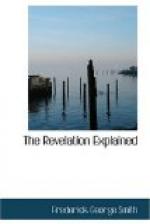Here again the narrative returns to take up another series of the history. A number of times we have been taken over the same ground. It is this feature of the Apocalypse more than any other that has misled and perplexed commentators. Attempting to explain it as one continuous narrative from beginning to end, they have been compelled to consider numerous passages as “digressions,” “parentheses,” or “episodes,” etc. As already observed, however, the prophecy is not arranged after the ordinary plan of histories, narrating all the contemporaneous events in a given period, whether civil, religious, literary, scientific, or biographical, thus finishing up the history of that period; but it consists of a number of distinct themes running over the same ground.
In this chapter a more particular description of the church of Rome, “that great city which reigneth over the kings of the earth” (verse 18), is given under the symbol of a drunken harlot. With this vile prostitute “the kings of the earth have committed fornication”—they have encouraged her in her corruption and idolatries—“and the inhabitants of the earth have been made drunk with the wine of her fornication.” This latter symbol is doubtless taken from the cup of drugged wine with which lewd women were accustomed to inflame their lovers. So had this apostate church made “the inhabitants of the earth”—of the ten kingdoms—drunken with her wine-cup and thus rendered them willing partakers in her abominable idolatries. She is described in two positions—first, as “sitting upon many waters,” which the angel informs us “are peoples, and multitudes, and nations, and tongues” (verse 15); and second, “upon a scarlet-colored beast, full of names of blasphemy, having seven heads and ten horns.” The first position denotes her wide supremacy in the world over distant peoples and nations; the second, the close relationship that she sustained to the civil power. That beast carried her in royal state. The civil powers of Europe have usually lent themselves as a caparisoned hack for this great whore to ride upon and have considered themselves highly honored thereby. This beast was full of the names of blasphemy, which were the same as the blasphemous assumptions of the Papacy, as explained in chapter XIII, showing that he agreed perfectly with this apostate church in her impious claims and supported her in them, making himself equally guilty and deserving of the same name. What is intended exactly by his scarlet color I do not know. The same power under its Pagan form was represented as a red dragon.
The appearance of this woman was that of the most splendid character, nor are we to suppose the contrary because she was such an infamous prostitute. She may have been, and according to the description was, all that, but still her appearance was such as to bewitch her admirers and votaries. Robes of purple and scarlet, with the most costly profusion of gold and diamonds, were superb adorning, even regal splendor. All that skill and wealth could do in magnificence of attire was bestowed upon her to set forth her charms. The “golden cup in her hand” was as to richness in harmony with her dress, while as to contents it set forth her character, for it was “full of abominations and filthiness of her fornication.” This cup was an appropriate symbol of her atrocious wickedness and idolatries.




